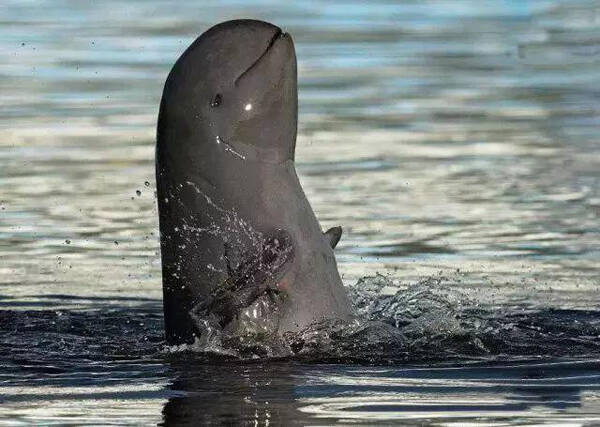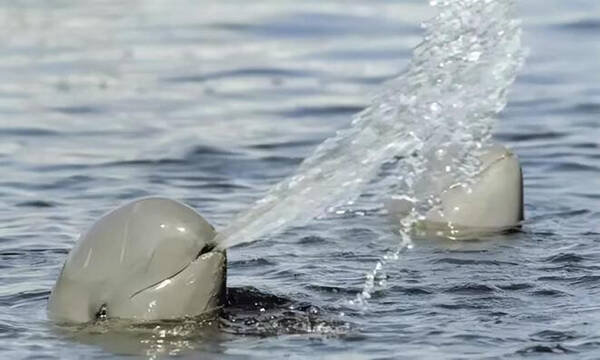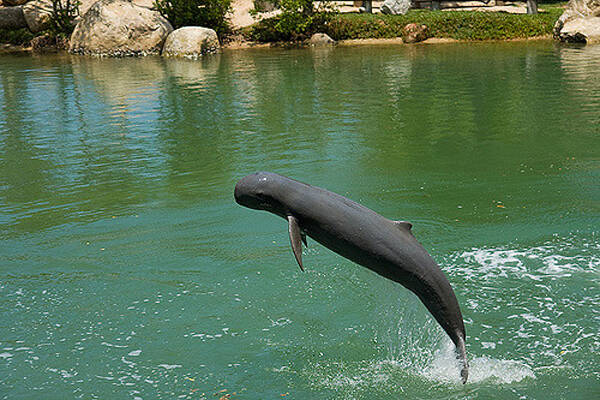Orcaella brevirostris
IUCN
LCBasic Information
Scientific classification
- name:Orcaella brevirostris
- Scientific Name:Irrawaddy dolphin, fin dolphin
- Outline:Cetacea
- Family:Delphinidae s.dolphin
Vital signs
- length:1.46-2.75m
- Weight:114-143kg
- lifetime:About 28 years
Feature
The body is stout, round and streamlined, with a large forehead and a blunt and round head.
Distribution and Habitat
Distributed intermittently in tropical and subtropical areas of the Indo-Pacific.
Origin: Bangladesh, Brunei, Cambodia, India, Indonesia, Laos, Malaysia, Myanmar, Philippines, Singapore, Thailand, Vietnam.
Mainly inhabits coastal areas, particularly muddy brackish waters of estuaries and deltas, and may not venture far from the coast. Some populations seem to occur only in freshwater areas, such as Lake Chilkat.
Appearance
The Yi River dolphin is stout and has a round and streamlined body. The forehead is large and the head is blunt and round. The beak is not obvious, and the lip line is straight (there are individual differences, and the lip line will change). The neck is flexible, has significant folds and is slightly concave (there are individual differences). The front edge of the pectoral fin is obviously curved. Some pectoral fins are long and wide in the shape of a spatula, and some have sharp ends (there are individual differences). The dorsal fin is small, slightly triangular, located in the center and slightly behind the body (the dorsal fin of males is usually larger than that of females). Tail shaft narrow. The caudal fin is wide and the trailing edge is concave inward; the central notch of the caudal fin is obvious.
Body color ranges from dark blue-grey, medium gray to light blue (some individuals are very dark). The back is bluish gray. The belly is usually lighter in color than the back
Details
Irrawaddy dolphin (scientific name: Orcaella brevirostris), foreign name Irrawaddy dolphin, no subspecies.

Irrawaddy dolphins are social animals, usually 3 to 6 in groups, the social behavior of group members occurs within and outside the group, and they also swim with other groups. When Irrawaddy dolphins are scouting, they will stick their heads out of the water to look around. When they surface to breathe, only the top of their heads are exposed, and this process is very short. Irrawaddy dolphins in Lake Chilka are known to swim up to the sandbar at the mouth of the river, rolling in the sand and retreating into the water if disturbed.
Irrawaddy dolphins swim slowly and leisurely. They rise to the surface with a steady, slow rolling motion. They dive for about 30 to 60 seconds, often taking three quick breaths in succession; when startled, they can stay in the water for up to 12 minutes. Between multiple deep dives, they surface only 14% of the time (compared to the total number of dives), and surface movements during these times include spinning, splashing or hitting the waves, and slapping the water. Peeping, tail slapping, jumping, blowing bubbles, rolling sideways, and staying on the surface are common; "spitting" water is also common, but the reason for this behavior is unknown. Irrawaddy dolphins use small horizontal leaps that do not completely leave the water. They arch their tail shaft when diving deeply. They may "spit" water from the mouth when peeping. Jet is often difficult to see. It is unknown whether there is bow-riding action. There have been records of cooperating with fishermen in the Irrawaddy and Mekong rivers to drive schools of fish into fishing nets.

The Irrawaddy dolphin mainly feeds on fish, cephalopods and crustaceans, occasionally spitting water at schools of fish when hunting.
Irrawaddy dolphins communicate using clicks, chirps and buzzes, with a main frequency of 60 kHz, which may also be used for echolocation.

The mating season in the northern hemisphere is from December to June of the following year, and the birthing period lasts from about June to August (the exception is the Chilka Lake in India, where the Irrawaddy dolphins have a very low reproduction rate, producing only one calf in three years). The gestation period is about 9 months (the gestation period of two captive breeding individuals is 14 months). The newborn dolphin is 96 cm long and weighs 12.3 kg. In the first 7 months after birth, the calves increase in length and weight by 59% and 266% respectively. At about 6 months old, the calves begin to eat fish; they are completely weaned at around 2 years old; and they grow into adult dolphins in 3 to 5 years. The sexual maturity of Irrawaddy dolphins is considered to be positively correlated with growth rate. Like most mammals, mother dolphins invest a lot of time in raising their calves. From birth to 7 months old, the calves are completely dependent on their mothers for nutrition; after 7 months, the calves stay in the dolphin group and continue to be fed by their mothers, but also catch fish. The maximum age record of Irrawaddy dolphins comes from dead samples caught in fishing nets, which is about 28 years old.
The global population of Irrawaddy dolphins has not been surveyed, and there are no estimates of regional numbers. Rigorous population counts have been made only in small areas: 77 (CV=27.4%) individuals in the Malampaya Sea of the Philippines (Smith et al. 2004); at least 125 (95% CI=114-152) individuals in the Mekong River (Beasley et al. 2007); 70 (CV=10%; 95% CL=58-79) individuals in the Mahakam River of Indonesia (Kreb et al. 2007); about 58-72 individuals in the Irrawaddy River of Myanmar (Smith et al. 2007); 5,383 individuals in coastal waters of Bangladesh (Smith et al. 2005); and 451 (CV=9.6%) individuals in the Sundarbans mangroves of Bangladesh (Smith et al. 2006).
Listed in Appendices I and II of the Convention on the Conservation of Migratory Species of Wild Animals (CMS).
Listed in Appendix I of the Convention on International Trade in Endangered Species of Wild Fauna and Flora (CITES).
Listed in the IUCN Red List: Vulnerable (VU), assessed in 2008.
Listed in China's National Key Protected Wildlife List: National Class II Protected Animal (effective December 10, 1988, Cetacean*Other Whales).
Protect wild animals and stop eating game.
Maintaining ecological balance is everyone's responsibility!








